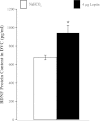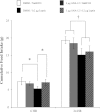TrkB receptor signaling in the nucleus tractus solitarius mediates the food intake-suppressive effects of hindbrain BDNF and leptin
- PMID: 22374757
- PMCID: PMC3361983
- DOI: 10.1152/ajpendo.00025.2012
TrkB receptor signaling in the nucleus tractus solitarius mediates the food intake-suppressive effects of hindbrain BDNF and leptin
Abstract
Brain-derived neurotrophic factor (BDNF) and TrkB receptor signaling contribute to the central nervous system (CNS) control of energy balance. The role of hindbrain BDNF/TrkB receptor signaling in energy balance regulation is examined here. Hindbrain ventricular BDNF suppressed body weight through reductions in overall food intake and meal size and by increasing core temperature. To localize the neurons mediating the energy balance effects of hindbrain ventricle-delivered BDNF, ventricle subthreshold doses were delivered directly to medial nucleus tractus solitarius (mNTS). mNTS BDNF administration reduced food intake significantly, and this effect was blocked by preadministration of a highly selective TrkB receptor antagonist {[N2-2-2-Oxoazepan-3-yl amino]carbonyl phenyl benzo (b)thiophene-2-carboxamide (ANA-12)}, suggesting that TrkB receptor activation mediates hindbrain BDNF's effect on food intake. Because both BDNF and leptin interact with melanocortin signaling to reduce food intake, we also examined whether the intake inhibitory effects of hindbrain leptin involve hindbrain-specific BDNF/TrkB activation. BDNF protein content within the dorsal vagal complex of the hindbrain was increased significantly by hindbrain leptin delivery. To assess if BDNF/TrkB receptor signaling acts downstream of leptin signaling in the control of energy balance, leptin and ANA-12 were coadministered into the mNTS. Administration of the TrkB receptor antagonist attenuated the intake-suppressive effects of leptin, suggesting that mNTS TrkB receptor activation contributes to the mediation of the anorexigenic effects of hindbrain leptin. Collectively, these results indicate that TrkB-mediated signaling in the mNTS negatively regulates food intake and, in part, the intake inhibitory effects of leptin administered into the NTS.
Figures






Similar articles
-
Influence of brain-derived neurotrophic factor-tyrosine receptor kinase B signalling in the nucleus tractus solitarius on baroreflex sensitivity in rats with chronic heart failure.J Physiol. 2016 Oct 1;594(19):5711-25. doi: 10.1113/JP272318. Epub 2016 Jun 9. J Physiol. 2016. PMID: 27151332 Free PMC article.
-
Medial nucleus tractus solitarius oxytocin receptor signaling and food intake control: the role of gastrointestinal satiation signal processing.Am J Physiol Regul Integr Comp Physiol. 2015 May 1;308(9):R800-6. doi: 10.1152/ajpregu.00534.2014. Epub 2015 Mar 4. Am J Physiol Regul Integr Comp Physiol. 2015. PMID: 25740340 Free PMC article.
-
Endogenous leptin receptor signaling in the medial nucleus tractus solitarius affects meal size and potentiates intestinal satiation signals.Am J Physiol Endocrinol Metab. 2012 Aug 15;303(4):E496-503. doi: 10.1152/ajpendo.00205.2012. Epub 2012 Jun 12. Am J Physiol Endocrinol Metab. 2012. PMID: 22693203 Free PMC article.
-
The nucleus tractus solitarius: a portal for visceral afferent signal processing, energy status assessment and integration of their combined effects on food intake.Int J Obes (Lond). 2009 Apr;33 Suppl 1:S11-5. doi: 10.1038/ijo.2009.10. Int J Obes (Lond). 2009. PMID: 19363500 Review.
-
The role of the leptin-melanocortin signalling pathway in the control of food intake.Crit Rev Eukaryot Gene Expr. 2009;19(4):267-87. doi: 10.1615/critreveukargeneexpr.v19.i4.20. Crit Rev Eukaryot Gene Expr. 2009. PMID: 19817705 Review.
Cited by
-
The Role of BDNF and TrkB in the Central Control of Energy and Glucose Balance: An Update.Biomolecules. 2024 Mar 31;14(4):424. doi: 10.3390/biom14040424. Biomolecules. 2024. PMID: 38672441 Free PMC article. Review.
-
Unraveling the brain regulation of appetite: lessons from genetics.Nat Neurosci. 2012 Oct;15(10):1343-9. doi: 10.1038/nn.3211. Epub 2012 Sep 25. Nat Neurosci. 2012. PMID: 23007189 Review.
-
Daily visual stimulation in the critical period enhances multiple aspects of vision through BDNF-mediated pathways in the mouse retina.PLoS One. 2018 Feb 6;13(2):e0192435. doi: 10.1371/journal.pone.0192435. eCollection 2018. PLoS One. 2018. PMID: 29408880 Free PMC article.
-
Mechanism of hyperphagia contributing to obesity in brain-derived neurotrophic factor knockout mice.Neuroscience. 2013 Jan 15;229:176-99. doi: 10.1016/j.neuroscience.2012.09.078. Epub 2012 Oct 13. Neuroscience. 2013. PMID: 23069761 Free PMC article.
-
Sex differences in stress-induced social withdrawal: role of brain derived neurotrophic factor in the bed nucleus of the stria terminalis.Front Behav Neurosci. 2014 Jan 9;7:223. doi: 10.3389/fnbeh.2013.00223. eCollection 2013. Front Behav Neurosci. 2014. PMID: 24409132 Free PMC article.
References
-
- Azzara AV, Sokolnicki JP, Schwartz GJ. Central melanocortin receptor agonist reduces spontaneous and scheduled meal size but does not augment duodenal preload-induced feeding inhibition. Physiol Behav 77: 411–416, 2002 - PubMed
-
- Bariohay B, Lebrun B, Moyse E, Jean A. Brain-derived neurotrophic factor plays a role as an anorexigenic factor in the dorsal vagal complex. Endocrinology 146: 5612–5620, 2005 - PubMed
-
- Bariohay B, Roux J, Tardivel C, Trouslard J, Jean A, Lebrun B. Brain-derived neurotrophic factor/tropomyosin-related kinase receptor type B signaling is a downstream effector of the brainstem melanocortin system in food intake control. Endocrinology 150: 2646–2653, 2009 - PubMed
-
- Beckers S, Peeters A, Zegers D, Mertens I, Van Gaal L, Van Hul W. Association of the BDNF Val66Met variation with obesity in women. Mol Genet Metab 95: 110–112, 2008 - PubMed
Publication types
MeSH terms
Substances
Grants and funding
LinkOut - more resources
Full Text Sources

